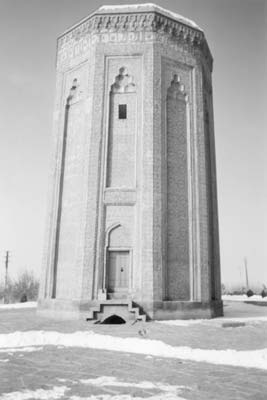Naxcivan of Azerbaijan
Nakhichevan or Naxcivan: whatever the name, it’s a small piece of land separated from but part of Azerbaijan. It’s located 250 miles west of Baku, the country’s capital, and is surrounded by Armenia, Iran and Turkey.
When I visited the domestic airlines office in Baku in late January ’07, the staff looked at me as if I’d just turned green and walked through a wall. Foreigners don’t go there, they told me, and they tried to discourage me by saying that a special visa is required, which is not true. On it went for two hours before I finally received my $100 ticket.
On my arrival, blinking from a foot of snow that covered everything and not wearing black from hat to shoes like my fellow passengers, it didn’t take long for the local gestapo to single me out. After 10 minutes of hostile stares and passport examination, I was allowed to enter.
The taxi took me to a brand-new and totally sterile hotel a mile outside of town, the Grand, I believe. I quickly said “No” and headed to town to see if anything else was available. For 10 bucks I took a room at the Ateshgat, an establishment with bathrooms downstairs and with the upstairs rooms warmed by a central gas heater. (I had to keep the door open to keep from freezing.)
I was ready to get out of there and do some beer drinking. Word was soon out, and the only English-speaking person within a hundred miles found me and off we went barhopping.
The town, also called Naxcivan, is small but somehow supports 10 museums. The next morning, my English-speaking friend and I visited all of them. Two were noteworthy: the first was dedicated to the late president, who is from the area (his son now rules Azerbaijan), and the second was a most impressive mausoleum. At both I was treated like foreign royalty. Gifts, questions and stares: I handled them all like a prince.
The mausoleum, like the Taj Mahal, is the resting place of a queen, Momina-Khatun, and was constructed by a grieving king. This circular structure is not the Taj, but at 85 feet tall and maybe 35 feet wide it is the most impressive building in the country. The mausoleum, along with two others outside of town, all were built by bereaved kings in the 12th and 13th centuries.
Later, I was on the most dilapidated plane on which I’ve ever flown and heading back to the city lights of Baku. I liked Naxcivan like a Peace Corps volunteer likes his posting, no matter where, and, while I might not return, I recommend it to fellow travelers.
KURT SHAFER
Chatsworth, IL

